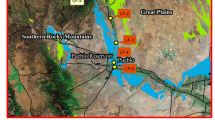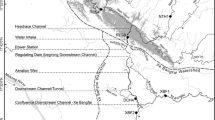Abstract
The effects of water quality and exposure to trace elements in irrigation return flows on bluegills (Lepomis macrochirus) were studied in the Merced River and Salt Slough, tributaries to the San Joaquin River, California, during 1988. Our study revealed that conductivity, turbidity, pH, total filterable residue, total hardness, and alkalinity were significantly greater in the Salt Slough, which receives tile drainage, then in the Merced River, which does not receive tile drainage. The concentrations of all trace elements, except aluminum and selenium, were below levels that are expected to have significant chronic toxic effects on bluegills. Selenium body burdens in bluegills from the Salt Slough have increased over fourfold since 1973. Age 1 bluegills from the Salt Slough were significantly shorter than age 1 bluegills from the Merced River. No other significant differences were noted in length by age. The mean length of age 1 bluegills from the Merced River has been increasing since 1983. In contrast, the length of age 1 bluegills from the Salt Slough has been decreasing. Fecundity of bluegills was lower in the Salt Slough than in the Merced River. The concurrent rise in selenium body burdens in bluegills from the Salt Slough and the decreasing total length of age 1 bluegills suggest a causal link between the two. In addition, the apparent depressed fecundity may also be related to the increased body burdens of selenium.
Similar content being viewed by others
References
Adams WJ (1976) The toxicity and residue dynamics of selenium in fish and aquatic invertebrates. PhD dissertation, Michigan State University, East Lansing, MI
Agee BA (1986) Toxic substances monitoring program, 1984. Water quality monitoring report No. 86–4WQ, California State Water Resources Control Board, Sacramento, CA
American Public Health Association, American Water Works Association, and Water Pollution Control Federation (1975) Standard methods for the examination of water and wastewater. Franson MA, Rand MC, Greenberg AE, Taras MJ (eds). American Public Health Association, Washington, DC, 1193 pp
Baumann PC, Gillespie RB (1986) Selenium bioaccumulation in gonads of largemouth bass and bluegill from three power plant cooling reservoirs. Environ Toxicol Chem 5:695–701
Bauman PC, May TW (1984) Selenium residues in fish from inland waters of the United States. Workshop proceedings: The effects of trace elements on aquatic ecosystems. Electric Power Research Institute, EPRI EA-3329, Project 1631, Palo Alto, CA
Beck LA (1984) Case history: San Joaquin Valley, Calif Agricult 38:16–17
Bennett WN, Brooks AS, Boraas ME (1986) Selenium uptake and transfer in an aquatic food chain and its effects on fathead minnow larvae. Arch Environ Contam Toxicol 15:513–517
Benoit DA (1975) Chronic effects of copper on survival, growth, and reproduction of the bluegill (Lepomis macrochirus). Trans Am Fish Soc 104:353–358
Brown DJA (1983) Effect of calcium and aluminum concentrations on the survival of brown trout (Salmo trutta) at low pH. Bull Environ Contam Toxicol 30:582–587
Carlander KD (1977) Handbook of freshwater fishery biology—Volume Two—Life history data on centrachid fishes of the United States and Canada. Iowa State University Press, Ames, IA, 431 pp
Collins PL (1977) Humboldt State University computer program library documentation for program growth. Humboldt State University Computer Center, Arcata, CA, pp 4–15
Cumbie PM, Van Horn SL (1979) Selenium accumulation associated with fish mortality and reproductive failure. Proc Annu Conf Southeast Assoc Fish Wildlife Agencies 32:612–624
Driscoll CD, Baker JP, Bisogni JJ, Schofield CL (1980) Effect of aluminum speciation on fish in dilute acidified waters. Nature 284:161–164
Fraser CMcL (1916) Growth of the spring salmon. Trans Pacif Fish Soc Seattle, for 1915, pp 29–39
Frieden E (1972) The chemical elements of life. Sci Am 227:52–60
Gilderhus PA (1966) Some effects of sublethal concentrations of sodium arsenic on bluegills and the aquatic environment. Trans Am Fish Soc 95:289–296
Gillespie RB, Baumann PC (1986) Effects of high tissue concentrations of selenium on reproduction by bluegills. Trans Am Fish Soc 115:208–213
Gillespie RB, Baumann PC, Singly CT (1988) Dietary exposure of bluegills (Lepomis macrochirus) to (75) Se: Uptake and distribution in organs and tissues. Bull Environ Contam Toxicol 40:771–778
Lee RM (1920) A review of the methods of age and growth determination in fish by means of their scales. (Statistical inquiry into the value of scale methods of research). Min Agricult and Fish, Fishery Inv Series II, IV:1–32
Lemly AD (1982) Response of juvenile centrarchids to sublethal concentrations of waterborne selenium. I. Uptake, tissue distribution, and retention. Aquat Toxicol 2:235–252
Lemly AD, Smith GJ (1987) Aquatic cycling of selenium: implications for fish and wildlife. Fish and Wildlife Leaflet 12, US Fish and Wildlife Service, Washington, DC, 10 pp
Mawson JC, Reed RJ (1969) Three computer programs: back-calculation, condition factor and stomach content, CDC 3600 Fortran/Format. J Fish Res Board Can 27:156–157
McKim JM (1977) Evaluation of tests with early life stages of fish for predicting long-term toxicity. J Fish Res Board Can 34:1148–1154 1154
Moyle PB (1976) Inland fishes of California. University of California Press, Berkeley, CA, 405 pp
National Fisheries Contaminant Research Center (1988) 1988 Research progress and evaluation report. National Fisheries Contaminant Research Center, Columbia, MO, 70 pp
Netter J, Wasserman W (1974) Applied linear statistical models. Richard D. Irwin, Inc. Homeweed, IL, 842 pp
Pagenkopf GK (1980) Zinc speciation and toxicity to fish. In: Nriagu JO (ed) Zinc in the environment: Part II, Health effects. John Wiley & Sons, NY, 480 pp
Pagenkopf GK, Russo RC, Thurston RV (1974) Effect of complexation on toxicity of copper to fishes. J Fish Res Board Canada 31:462–465
Sager DR, Cofield CR (1984) Differential accumulation of selenium among axial muscle, reproductive and liver tissues of four warmwater fish species. Water Res Bull 20:359–363
Saiki MK (1984) Environmental conditions and fish faunas in low elevation rivers on the irrigated San Joaquin Valley floor, California. Calif Fish Game 70:145–157
— (1986) A field example of selenium contamination in an aquatic food chain. In: Symposium in the Environment, Proceedings, California State University, Fresno, CA, pp 67–76
Saiki MK, Schmitt CJ (1985) Population biology of bluegills, (Lepomis macrochirus), in lotic habitats on the irrigated San Joaquin Valley floor. Calif Fish Game 71:225–244
Saiki MK, May TW (1988) Trace element residues in bluegills and common carp from the lower San Joaquin River, California and its tributaries. Sci Total Environ 74:199–217
Shelton LR, Miller LK (1988) Water quality data, San Joaquin Valley, California, March 1985–March 1987. US Geol Surv, Open-File Report 88-479, 210 pp
Sorenson EMB, Bauer TL, Harlan CW, Pradzynski AH, Bell JS (1983) Hepatocyte changes following selenium accumulation in a freshwater teolost. J Am Forensic Med Path 4:25–32
Sorensen SK, Hoffman RJ (1981) Water-quality assessment of the Merced River, California, in the 1977 water year. US Geol Surv, Water Resources Invest 80-75:1–31
Stuber RJ, Gebhart G, Maughan OE (1982) Habitat suitability index models: bluegills. USDI Fish and Wildlife Service. FWS/OBS-82/10.8, 26 pp
Tsai C, Chang K (1984) Intraspecific variation in copper susceptibility of bluegill sunfish. Arch Environ Contam Toxicol 13:93–99
US Bureau of Reclamation (1984) San Luis Unit, Central Valley Project, California, Information Bulletins 1, 2, 3, and 4. USBOR, Mid-Pacific Region, Sacramento, CA
Weisberg S, Frie RV (1987) Linear models for the growth of fish. In: Summerfelt RC, Hall GE (eds). Age and growth of fish. Iowa State University Press, Ames, IA, pp 127–143
Woock SE, Garrett WR, Partin WE, Bryson WT (1987) Decreased survival and teratogenesis during laboratory selenium exposures, (Lepomis macrochirus). Bull Environ Contam Toxicol 39:998–1005
Author information
Authors and Affiliations
Additional information
Cooperators are Humboldt State University, California Department of Fish and Game, and U.S. Fish and Wildlife Service.
Rights and permissions
About this article
Cite this article
Nakamoto, R.J., Hassler, T.J. Selenium and other trace elements in bluegills from agricultural return flows in the San Joaquin Valley, California. Arch. Environ. Contam. Toxicol. 22, 88–98 (1992). https://doi.org/10.1007/BF00213306
Received:
Issue Date:
DOI: https://doi.org/10.1007/BF00213306




